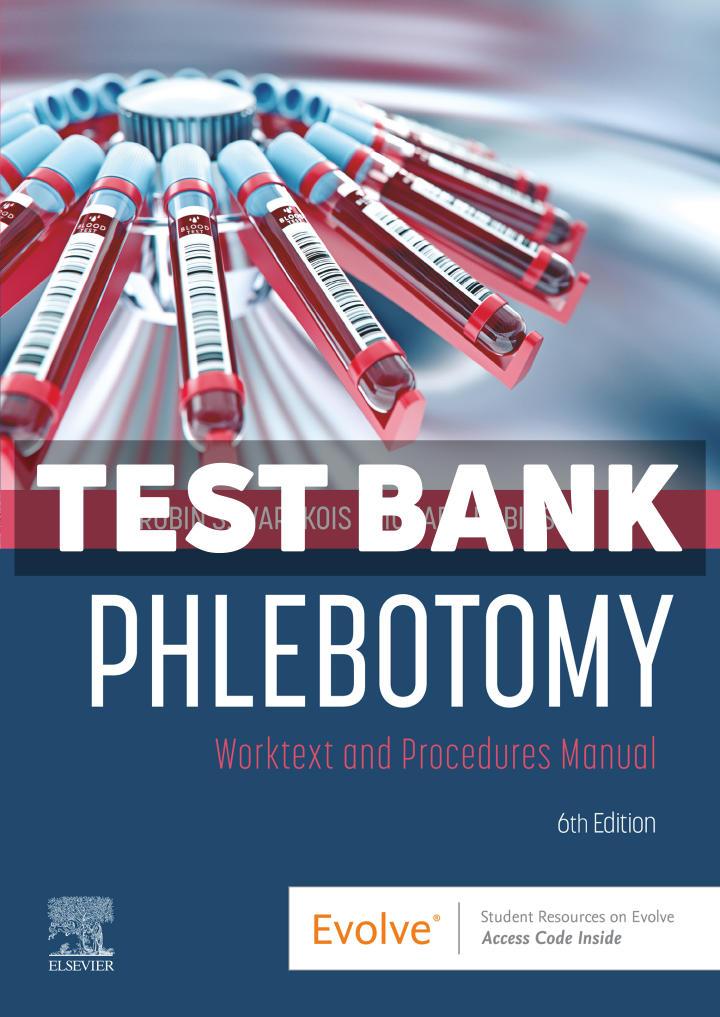

Test Bank - Chapter 01
Q: What does the term phlebotomy actually mean?
A. Removal of a vein
B. Incision of a vein (Correct)
C. Testing of blood
D. Withdrawal of red blood cells
Q: A duty associated with routine blood collection includes
A. ordering tests for patients.
B. transporting sample to laboratory. (Correct)
C. performing complex point-of-care testing.
D. setting HIPAA regulations for phlebotomy.
Q: Which of the following acronyms is not a certification agency for phlebotomists?
A. ASCP
B. ASPT
C. AMT
D. NAACLS (Correct)
Q: Which of the following terms is evidence that an individual has demonstrated proficiency in a particular area of practice?
A. Accreditation
B. Approval
C. Certification (Correct)
D. Standardization
Q: A phlebotomist must ensure that the patient understands and agrees that his or her blood is going to be drawn. What is the name of this process?
A. Confidentiality
B. Informed consent (Correct)
C. Legality
D. Privacy
Q: The Health Insurance Portability and Accountability Act of 1996 regulates which of the following areas?
A. Privacy of health information (Correct)
B. Health insurance transfers on changing jobs
C. Informing patients of intended procedures
D. Phlebotomy training
Q: You have entered a patient’s room and explained that you need to draw blood, and the patient repeatedly refuses. What should you do?
A. Attempt to draw it anyhow because the physician ordered the test.
B. Call for another phlebotomist to help you to convince the patient.
C. Take the request form back to the laboratory after you have finished drawing your other patients.
D. Notify the patient’s physician according to the institution’s written policies. (Correct)
Q: The term informed consent means
A. a patient must be informed of all intended treatments and risks before the treatment is performed. (Correct)
B. a patient must inform the physicians concerning what procedures they need.
C. a nurse informed by the phlebotomist can overrule a patient’s refusal.
D. as long as the patient is informed, he or she cannot refuse a treatment.
Q: Which of the following is true of phlebotomy?
A. Phlebotomy is an ancient profession dating back at least 3500 years. (Correct)
B. Phlebotomy is a new profession arising during World War II.
C. Phlebotomists today draw blood from patients for the same reasons as ancient phlebotomists.
D. Phlebotomy equipment has not changed since the original phlebotomists.
Q: Which of the following professionals performs a variety of tasks related to specimen preparation in the clinical laboratory?
A. Accessioner (Correct)
B. Laboratory assistant
C. Medical assistant
D. Medical technologist
Q: After becoming certified, what is a requirement to maintain that certification?
A. Take an annual phlebotomy course.
B. Complete a minimum of 500 sticks each year.
C. Participate in continuing education programs. (Correct)
D. Take a bi-annual national certification examination.
Q: What is the term given to any information about the patient’s health status, treatment, or payment for health care?
A. Demographics
B. Protected Health Information (Correct)
C. Diagnosis
D. Private Health Plan
Q: A successful quality healthcare professional is one who
A. exhibits emotional stability. (Correct)
B. maintains professional aloofness.
C. doesn’t get bogged down in the details.
D. waits for problems to arise versus before they arise.
